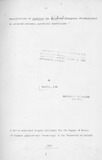| dc.description.abstract | Dysdercus species are important pests of cotton because of their staining effect on cotton lint. Chemical control, using the newer
generation of insecticides known as the synthetic pyrethroids, is the
most important method of control of these pests on cotton in Kenya at
present.
Susceptibility studies were conducted using three pyrethroids, namely Cypermethrin, Fenvalerate and permethrin against strains of Dysdercus fasciatus Sign., D. nigrofasciatus (Stal.), D. cardinalis (Gerst.) and D. superstitiosus (F.) collected from the field and raised in the laboratory to obtain test strains.
Laboratory observations showed that there were differences in
the susceptibility levels of the four species studied. The most
susceptible species to the three insecticides was D. fasciatus. On the other hand D. cardinalis and D. nigrofasciatus displayed the least
susceptibility to the test insecticides.
It was also observed that there were differences in the susceptibilities of different strains of the four Dysdercus species to the chemicals tested. The most susceptible strain to all the insecticides used was that of D. fasciatus collected from Masongoleni in Machakos District. Among the D. fasciatus strains, the most resistant strain was that which was collected from Kibos. Among the rest of the species, the D. nigrofasciatus strain collected from
Homabay and the D. cardinalis strain collected from Kibos were the
Wkle^
most resistant to the test insecticides. The toxicity of the three
«•
insecticides based on the topical application technique was found to be in descending order of effectiveness-.Cypemethrin, fenvaierate
and permethrin.
Two species, namely D. cardinalis .and D. nigrofasciatus were
subjected to insecticidal selection pressure for five generations
\
to ascertain whether resistance could be induced in them against cypermethrin, fenvalerate and permethrin.
2* cardinalis when treated with permethrin gave the highest selection response shown by a resistance factor of x2.7. Treatment of D. cardinalis and D. nigrofasciatus with cypermethrin and fenvalerate gave resistance factors of between x0.8 and xl.6. In view of the experimental evidence gathered during these studies that Dysdercus species have the propensity for development of resistance to the synthetic pyrethroids, it was considered that selection for f ive generations was not sufficient to induce high levels of resistance in these species. It is suggested that frequent tests be carried out on Dysdercus species in order to monitor the development of resistance in them in Kenya.
Investigations into the residual persistence of cypermethrin,
fenvalerate and peimethrin revealed that of the three insecticides,
Cypermethrin had the longest residual persistence of 21 days under
field conditions at Kibos. It was also observed that for each of the
three insecticides there were significant (P<0.05) differences in
their residual persistence during the experimental period. These
observations also revealed that the synthetic pyrethroid insecticides
used in this study have a short residual life ranging from 7 to 21
days under field conditions. On the basis of these observations it
was concluded that the field application interval for cypermethrin
for the control of cotton staiqers should be 21 days. On the other
*
hand, fenvalerate and permethrin were found to perform well against these pests at application intervals of 14 days. Because of this
it was recommended that they should be applied at that interval. Data obtained in studies reported in this thesis indicated that typermethrin had a residual toxicity by a factor of about x5 in comparison to both fenyalerate and permethrin. Cypermethrin was therefore regarded as being the most effective against Dysdercus in comparison to the other two compounds tested.
V I 1
it was recommended that they should be applied at that interval. Data obtained in studies reported in this thesis indicated that typermethrin had a residual toxicity by a factor of about x5 in comparison to both FenValerate and permethrin. Cypermethrin was therefore regarded as being the most effective against Dysdercus in comparison to the other two compounds tested | |

